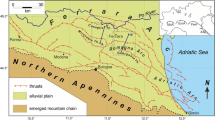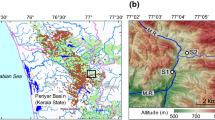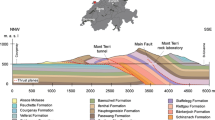Abstract
The Mirandola anticline represents a buried fault-propagation fold which has been growing during Quaternary due to the seismogenic activity of a blind segment belonging to the broader Ferrara Arc. The last reactivation occurred during the May 2012 Emilia sequence. In correspondence with this structure, the thickness of the marine and continental deposits of the Po Plain foredeep is particularly reduced. In order to better define the shallow geometry of this tectonic structure, and hence its recent activity, we investigated in a depth range which is intermediate between the surficial morphological observations and seismic profiles information. In particular, we carried out numerous passive seismic measurements (single-station microtremor) for obtaining the horizontal-to-vertical spectral ratio. The results of a combined analysis of the peak frequency and its amplitude nicely fit the available geological information, suggesting that this low-cost geophysical technique could be successfully applied in other sectors of wide morphologically flat alluvial plains to investigate blind and completely buried potential seismogenic structures.









Similar content being viewed by others
References
Amorosi A, Castellaro S, Mulargia F (2008) Single-station passive seismic stratigraphy: an inexpensive tool for quick subsurface investigations. GeoActa 7:29–39
Bard P-Y, Acerra C, Alguacil G, Anastasiadis A, Atakan K, Azzara R, Basili R, Bertrand E, Bettig B, Blarel F, Bonnefoy-Claudet S, Bordoni P, Borges A, Bøttger-Sørensen M, Bourjot L, Cara F, Caserta A, Chatelain J-L, Cornou C, Cotton F, Cultrera G, Daminelli R, Dimitriu P, Dunand F, Duval A-M, Fäh D, Fojtikova L, de Franco R, di Giulio G, Grandison M, Guéguen P, Guillier B, Haghshenas E, Havskov J, Jongmans D, Kind F, Kirsch J, Koehler A, Koller M, Kristek J, Kristekova M, Lacave C, La Rocca M, Marcellini A, Maresca R, Margaris B, Moczo P, Moreno B, Morrone A, Ohrnberger M, Ojeda JA, Oprsal I, Pagani M, Panou A, Paz C, Querendez E, Rao S, Rey J, Richter G, Rippberger J, Roquette P, Roten D, Rovelli A, Saccoroti G, Savvaidis A, Scherbaum F, Schisselé E, Spühler-Lanz E, Tento A, Teves-Costa P, Theodulidis N, Tvedt E, Utheim T, Vassiliadès J-F, Vidal S, Viegas G, Vollmer D, Wathelet M, Woessner J, Wolff K, Zacharapoulos S (2005) Guidelines for the implementation of the H/V spectral ratio technique on ambient vibrations measurements, processing and interpretation. Deliverable D23.12 of the SESAME project, April 2005. http://www.SESAME-FP5.obs.ujf-grenoble.fr
Basili R, Valensise G, Vannoli P, Burrato P, Fracassi U, Mariano S, Tiberti MM, Boschi E (2008) The Database of Individual Seismogenic Sources (DISS), version 3: summarizing 20 years of research on Italy’s earthquake geology. Tectonophysics 453(1–4):20–43. doi:10.1016/j.tecto.2007.04.014
Bigi G, Bonardini G, Catalano R, Cosentino D, Lentini F, Parlotto M, Sartori R, Scandone P, Turco E (1992) Structural model of Italy, 1:500,000. Consiglio Nazionale delle Ricerche, Rome
Bignami C, Burrato P, Cannelli V, Chini M, Falcucci E, Ferretti A, Gori S, Kyriakopoulos C, Melini D, Moro M, Novali F, Saroli M, Stramondo S, Valensise G, Vannoli P (2012) Coseismic deformation pattern of the Emilia 2012 seismic sequence imaged by Radarsat-1 interferometry. Ann Geophys 55(4):788–795. doi:10.4401/ag-6157
Boccaletti M, Bonini M, Corti G, Gasperini P, Martelli L, Piccardi L, Tanini C, Vannucci G (2004) Seismotectonic Map of the Emilia-Romagna Region, 1:250000. Regione Emilia-Romagna—CNR
Bonini L, Toscani G, Seno S (2014) Three-dimensional segmentation and different rupture behavior during the 2012 Emilia seismic sequence (Northern Italy). Tectonophysics 630:33–42. doi:10.1016/j.tecto.2014.05.006
Burrato P, Ciucci F, Valensise G (2003) An inventory of river anomalies in the Po Plain, Northern Italy: evidence for active blind thrust faulting. Ann Geophys 46(5):865–882
Burrato P, Vannoli P, Fracassi U, Basili R, Valensise G (2012) Is blind faulting truly invisible? Tectonic-controlled drainage evolution in the epicentral area of the May 2012, Emilia-Romagna earthquake sequence (Northern Italy). Ann Geophys 55(4):525–531. doi:10.4401/ag-6182
Butler DK, Curro JR (1981) Crosshole seismic testing; procedures and pitfalls. Geophysics 46(1):23–29. doi:10.1190/1.1441134
Caputo R (2005) Ground effects of large morphogenic earthquakes. J Geodyn 40(2–3):113–118
Caputo R, Pellegrinelli A, Bignami C, Bondesan A, Mantovani A, Stramondo S, Russo P (2015) High-precision levelling, DInSAR and geomorphological effects in the Emilia 2012 epicentral area. Geomorphology 235:106–117. doi:10.1016/j.geomorph.2015.02.002
Castellaro S, Mulargia F (2009) Vs30 estimates using constrained H/V measurements. Bull Seismol Soc Am 99:761–773. doi:10.1785/0120080179
Castellaro S, Mulargia F, Bianconi L (2005) Passive seismic stratigraphy: a new efficient, fast and economic technique. J Geotech Environ Geol 3:51–77
Castellaro S, Padròn LA, Mulargia F (2014) The different response of apparently identical structures: a far-field lesson from the Mirandola 20th May 2012 earthquake. Bull Earthq Eng 12(5):2481–2493. doi:10.1007/s10518-013-9505-9
DISS WORKING GROUP (2015) Database of Individual Seismogenic Sources (DISS), Version 3.2.0: a compilation of potential sources for earthquakes larger than M 5.5 in Italy and surrounding areas. http://diss.rm.ingv.it/diss/, ©INGV 2015—Istituto Nazionale di Geofisica e Vulcanologia—All rights reserved. doi: 10.6092/INGV.IT-DISS3.2.0
Gallipoli MR, Mucciarelli M, Gallicchio S, Tropeano M, Lizza C (2004) Horizontal to vertical spectral ratio (HVSR) measurements in the area damaged by the 2002 Molise, Italy, earthquake. Earthq Spect 20(S1):S81–S93. doi:10.1193/1.1766306
Gosar A, Lenart A (2010) Mapping the thickness of sediments in the Ljubljana Moor basin (Slovenia) using microtremors. Bull Earthq Eng 8:501–518. doi:10.1007/s10518-009-9115-8
Ibs-von SM, Wohlenberg J (1999) Microtremor measurements used to map thickness of soft sediments. Bull Seismiol Soc Am 89(1):250–259
Koller M, Chatelain J-L, Guillier B, Duval A-M, Atakan K, Bard P-Y, SESAME Team (2004) Practical user guidelines and software for the implementation of the H/V ratio technique: measuring conditions, processing method and results interpretation. In: 13th World conference earthquake engineering, Vancouver, August 2004, proceedings, paper # 3132
Martelli L, Molinari FC (2008) Studio geologico finalizzato alla ricerca di potenziali serbatoi geotermici nel sottosuolo del comune di Mirandola, Regione Emilia Romagna. Internal Report, Servizio Geologico, Sismico e dei Suoli, Bologna, p 26
Micromed (2006) Grilla ver. 2.2, spectral and HVSR analysis—user’s manual. Micromed, Treviso, p 47
Micromed (2008) An introduction to the phase velocity spectra module in Grilla. Micromed, Treviso, p 16
Mucciarelli M, Contri P, Mochavesi G, Calvano G, Gallipoli MR (2001) An empirical method to assess the seismic vulnerability of existing buildings using the HVSR technique. Pure Appl Geophys 158:2635–2647
Nakamura Y (1989) A method for dynamic characteristics estimation of subsurface using microtremor on the ground surface. Quart Rep Railw Tech Res Inst RTRI 30:25–33
Oliveto AN, Mucciarelli M, Caputo R (2004) HVSR prospections in multi-layered environments: an example from the Tyrnavos Basin (Greece). J Seismol 8:395–406
Pezzo G, Merryman Boncori JP, Tolomei C, Salvi S, Atzori S, Antonioli A, Trasatti E, Novali F, Serpelloni E, Candela L, Giuliani R (2013) Coseismic deformation and source modeling of the may 2012 Emilia (Northern Italy) earthquakes. Seismol Res Lett 84(4):645–655. doi:10.1785/0220120171
Pieri M, Groppi G (1981) Subsurface geological structure of the Po Plain, Italy. Consiglio Nazionale delle Ricerche, Progetto finalizzato Geodinamica, sottoprogetto Modello Strutturale, pubbl. No. 414, Roma
Pondrelli S, Salimbeni S, Perfetti P, Danecek P (2012) Quick regional centroid moment tensor solutions for the Emilia 2012 (northern Italy) seismic sequence. Ann Geophys 55(4):615–621. doi:10.4401/ag-6146
Salvi S, Tolomei C, Merryman Boncori JP, Pezzo G, Atzori S, Antonioli A, Trasatti E, Giuliani R, Zoffoli S, Coletta A (2012) Activation of the SIGRIS monitoring system for ground deformation mapping during the Emilia 2012 seismic sequence, using COSMO-SkyMed InSAR data. Ann Geophys 55(4):796–802. doi:10.4401/ag-6181
Saraò A, Peruzza L (2012) Fault-plane solutions from moment-tensor inversion and preliminary Coulomb stress analysis for the Emilia Plain. Ann Geophys 55(4):647–654. doi:10.4401/ag-6134
Scognamiglio L, Margheriti L, Mele FM, Tinti E, Bono A, De Gori P, Lauciani V, Lucente FP, Mandiello AG, Marcocci C, Mazza S, Pintore S, Quintiliani M (2012) The 2012 Pianura Padana Emiliana seimic sequence: locations, moment tensors and magnitudes. Ann Geophys 55(4):549–556. doi:10.4401/ag-6159
Tarabusi G (2012) Microzonazione sismica del comune di Mirandola. Quadro conoscitivo del PSC di Mirandola. http://www.comune.mirandola.mo.it/la-citta-e-il-territorio/piano-strutturale-comunale-psc. Studio di Geologia Tarabusi, QB_C_REL1, 26 Jan 2012, Bologna, p 57
Vannoli P, Burrato P, Valensise G (2015) The seismotectonics of the Po Plain (Northern Italy): tectonic diversity in a blind faulting domain. Pure Appl Geophys 172:1105–1142. doi:10.1007/s00024-014-0873-0
Acknowledgments
We are grateful to Luca Martelli and Silvia Castellaro for their valuable and helpful suggestions. The pre-events microzonation study was financially supported by the Municipality of Mirandola and the Italian Dipartimento di Protezione Civile in the frame of an agreement with the regional administrations (OPCM 3907/2010, DGR 1051/2011).
Author information
Authors and Affiliations
Corresponding author
Rights and permissions
About this article
Cite this article
Tarabusi, G., Caputo, R. The use of HVSR measurements for investigating buried tectonic structures: the Mirandola anticline, Northern Italy, as a case study. Int J Earth Sci (Geol Rundsch) 106, 341–353 (2017). https://doi.org/10.1007/s00531-016-1322-3
Received:
Accepted:
Published:
Issue Date:
DOI: https://doi.org/10.1007/s00531-016-1322-3




